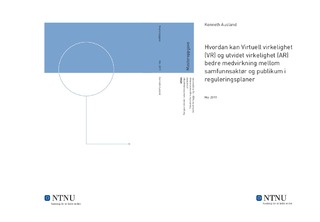| dc.contributor.advisor | Sager, Tore Øivin | |
| dc.contributor.advisor | Hjelseth, Eilif | |
| dc.contributor.author | Ausland, Kenneth | |
| dc.date.accessioned | 2020-03-05T15:00:21Z | |
| dc.date.available | 2020-03-05T15:00:21Z | |
| dc.date.issued | 2019 | |
| dc.identifier.uri | http://hdl.handle.net/11250/2645602 | |
| dc.description.abstract | Denne oppgaven utreder hvordan virtuell virkelighet (VR) og utvidet virkelighet (AR) kan gi bedre og mer reell medvirkning i planprosesser. Mye av forskning på medvirkning i planprosesser har handlet om hvorvidt medvirkning har skjedd og hvordan dialogen har foregått. Det har vært få studier som har rettet oppmerksomhet mot verktøyene som kan bidra til at befolkningen har forstått innholdet i planene de skal uttale seg om. Litteraturstudier viser at mål på forståelse, som persepsjon og tolkning, har blitt viet liten oppmerksomhet i evaluering av planprosesser. I denne oppgaven prøver jeg å rette fokus mot dette.
Utgangspunktet for oppgaven er mitt daglige virke som planlegger i Statens vegvesen. Det gir grunnlag for å analysere hvordan en stor planaktør har forholdt seg til de endringene i krav til medvirkning som har skjedd siden den første felles plan- og bygningsloven kom i 1985. Med dette utgangspunktet har jeg funnet at Vegvesenet allerede fra 1981 har hatt fokus på at medvirkning krever at planforslag må bli forstått.
Det viktigste utgangspunktet er forskningsspørsmålet, som dreier seg om hvorvidt ny teknologi som AR og VR kan gjøre planforslag og plankonsekvenser lettere å forstå for publikum og derigjennom gjøre medvirkning i planprosesser hjemlet i plan- og bygningsloven mer reell.
De overordnede hypotesene i denne oppgaven kan oppsummeres slik:
• Kan Virtuell virkelighet (VR) og utvidet virkelighet (AR) føre til en mer reell medvirkning i reguleringsplanarbeidet?
• Hvordan kan denne nye teknologien bidra til at planleggerne kan nå flere grupper i medvirkningsarbeidet i samsvar med Plan- og bygningsloven?
Til oppgaven har jeg produsert materiell: tegninger, presentasjonsmodell, bilder, illustrasjoner, virtuell virkelighetsmodell og utvidet virkelighetsmodell. I tillegg er det utarbeidet tradisjonelle plandokumenter. Jeg har deltatt i prosjektgruppen som har utført dette.
Det er gjennomført kvalitative intervju basert på fullskalaforsøk med medvirkning. Det er utført undersøkelser med rundt 30 kandidater, der jeg har gjennomført 10 kvalitative dybdeintervjuer med barn, unge og unge voksne. Det ble fokusert på forståelse og oppfatning. Et av hovedfunnene er at bruk av VR og AR skaper stort engasjement og entusiasme blant kandidatene.
Mitt arbeid viser at det er mulig å formidle planinnhold og plankonsekvenser på en måte som gjør berørte parter og interessenter i stand til å delta i reell medvirkning. Både AR og VR formidler planinnhold på en måte som forstås intuitivt. Rom for feiltolking og misforståelser reduseres og innsatsen kan fokuseres på å gi relevante innspill. | |
| dc.description.abstract | This thesis examines how virtual reality (VR) and augmented reality (AR) can give a better and more real participation in planning processes. A lot of the research on contribution to planning processes have dealt with whether there have been actual participation and how the dialogue has been conducted. Few studies have focused on the tools that can contribute to making the people understand what the plans they have to comment on actually contain. Literature studies show that measures of understanding, such as perception and interpretation, has been given little attention in evaluating planning processes. In this thesis I will focus on that.
My daily work as a planner in The Norwegian Public Roads Administration provides the basis to analyze how a large planning participant has dealt with changes in the participation requirements that have been implemented since the Planning and Building Act was first issued in 1985. I have found that the Roads Administration already focused on the fact that participation requires that planning proposals must be understood since 1981.
My research question is about whether new technology such as VR and AR can make planning proposals and planning consequences easier to understand for the audience and thereby make participation in planning processes authorized by the Planning and Building Act more real.
The research questions in this thesis are:
• Can virtual reality (VR) and augmented reality (AR) lead to a more real participation in the regulations work?
• How can this new technology contribute to planners reaching additional groups in participation work in accordance with the Planning and Building Act.
For this thesis I have produced the following materials: drawings, presentation models, pictures, illustrations, virtual reality models and augmented reality models. In addition, conventional planning documents have been made. I have participated in the project group which has done this.
I have completed qualitative interviews based on full scale testing with participation on 30 candidates, where I have made 10 qualitative depth interviews with kids, teenagers and young adults. The focus was on understanding and perception. One of the main findings was that the use of VR and AR creates a big engagement and enthusiasm among the candidates.
My work shows that it is possible to present planning content and planning consequences in such a way that makes the affected parties and stakeholders able to engage in a more real participation. Both AR and VR present planning content in a way that makes the understanding intuitive. The likelihood of misunderstandings and misinterpretations are reduced, and the efforts can be used to give relevant input. | |
| dc.language | nob | |
| dc.publisher | NTNU | |
| dc.title | Hvordan kan Virtuell virkelighet (VR) og utvidet virkelighet (AR) bedre medvirkning mellom samfunnsaktør og publikum i reguleringsplaner | |
| dc.type | Master thesis | |
